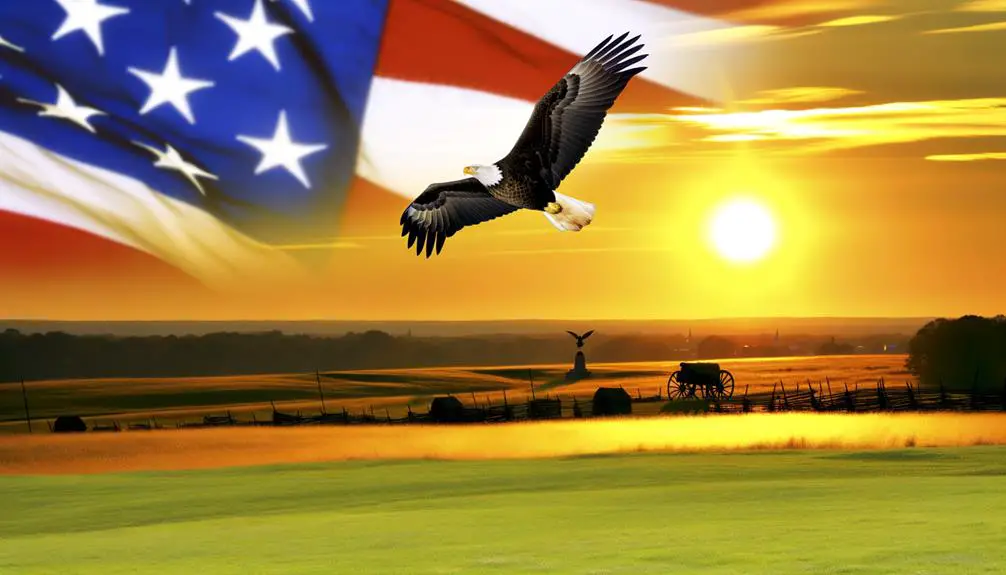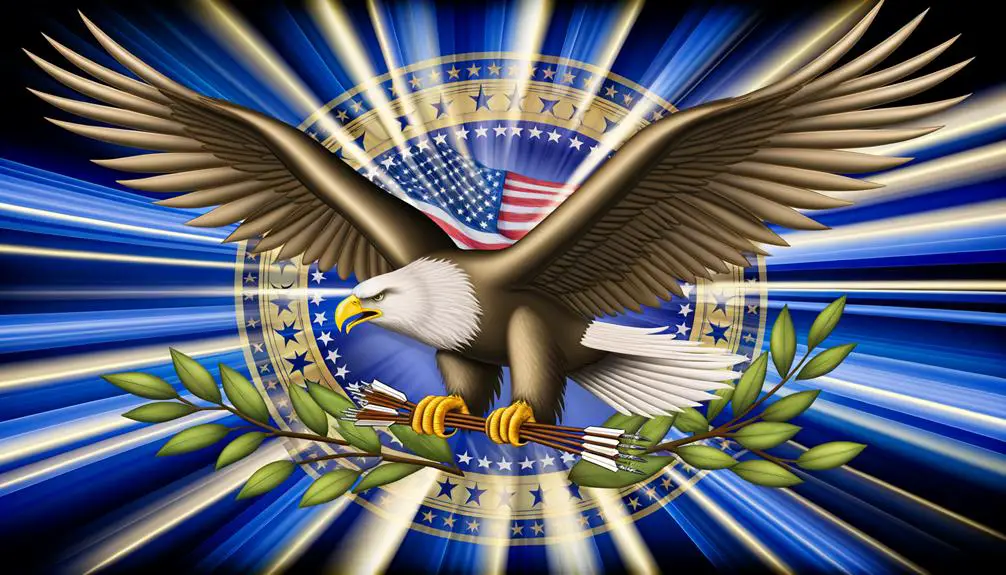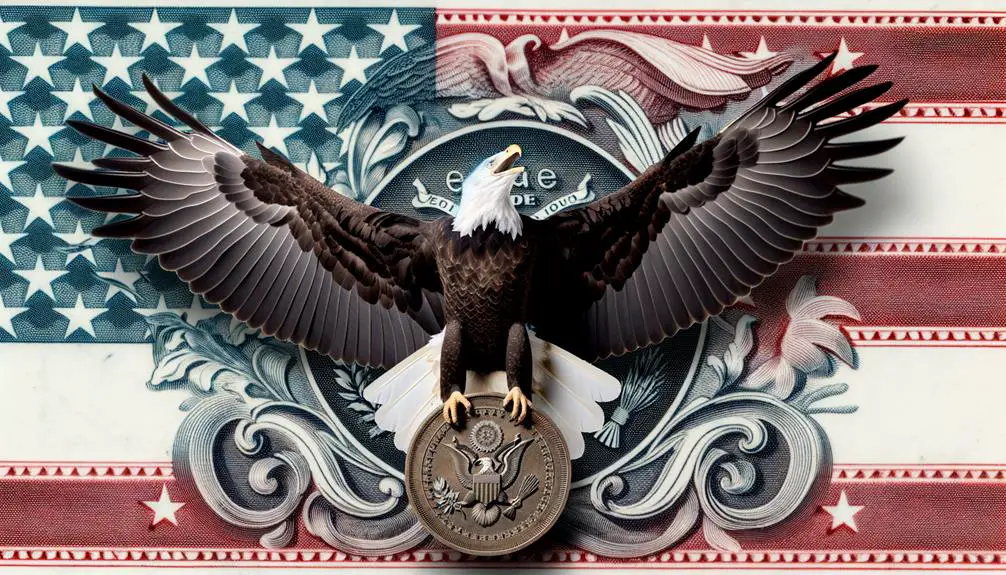American Bald Eagle: What Does It Symbolize for the U.S.?
The American Bald Eagle, Haliaeetus leucocephalus, epitomizes freedom, strength, and resilience, chosen as the U.S. national bird in 1782 for its distinctive white plumage and commanding presence.
Its monogamous behavior and collaborative parenting symbolize unity and responsibility. Known for keen vision and powerful talons, the eagle represents vigilance and power.
Its solitary flight and territorial nature align with ideals of independence and resilience. The species' conservation success underscores its enduring symbolism of recovery and strength.
Represented in art, government emblems, and media, it conveys core values of liberty and leadership. To uncover more nuances, continue exploring.

Key Takeaways
- The American Bald Eagle symbolizes freedom, strength, and resilience.
- Designated as the national bird in 1782, it embodies core American values of liberty and independence.
- Its physical traits, including a regal appearance and powerful talons, represent vigilance and power.
- The eagle signifies American ideals through its solitary flight patterns and territorial nature.
- The Bald Eagle's conservation success and cultural impact reinforce its association with national identity and sovereignty.
Historical Significance

The American Bald Eagle, scientifically known as Haliaeetus leucocephalus, has long held a pivotal role in the historical and cultural narrative of the United States, symbolizing freedom, strength, and resilience. This majestic raptor's presence in indigenous folklore and its later adoption by European settlers underscore its emblematic significance.
Its distinctive white head and tail feathers, contrasted with dark brown body plumage, accentuate its regal appearance. The eagle's keen vision and powerful talons are metaphors for vigilance and power, respectively. Historically, its ability to soar at great altitudes embodies the American spirit of aspiration and independence.
The Bald Eagle's behavioral traits, such as monogamy and collaborative parenting, further enrich its symbolic representation of unity and loyalty in American culture.
National Bird Selection

Building upon its historical significance, the American Bald Eagle was officially designated as the national bird of the United States in 1782, a decision rooted in its profound symbolic resonance and its embodiment of the nation's core values.
The selection process considered the bird's distinctive physical characteristics, such as its striking white head and tail, robust beak, and keen eyesight, which signify vigilance and strength. Behavioral observations highlighted its solitary yet majestic flight patterns and territorial nature, aligning with the ideals of independence and resilience.
Scientifically known as Haliaeetus leucocephalus, the Bald Eagle exhibits unique predatory behaviors and a diet mostly comprising fish, reflecting ecological adaptability. Therefore, its selection underscores a confluence of aesthetic, symbolic, and ecological attributes.
Symbol of Freedom

The American Bald Eagle, designated as the national emblem of the United States in 1782, embodies the country's foundational ideals of liberty and independence.
Its impressive wingspan and predatory prowess serve as a potent representation of strength and resilience.
This majestic raptor's soaring flight and commanding presence in the wild encapsulate the essence of freedom, making it an enduring symbol of the nation's core values.
National Emblem Significance
Embodying the ideals of liberty and independence, the American Bald Eagle has been revered as a powerful national emblem representing the United States' commitment to freedom. The choice of this raptor as a symbol is deeply rooted in its attributes: soaring flight, keen vision, and majestic presence, all of which metaphorically align with the nation's pursuit of lofty ideals and vigilant guardianship of liberty. The eagle's selection in 1782 was influenced by its North American exclusivity and its role in indigenous cultures as a symbol of power and spirit.
| Attribute | Description | Symbolism |
|---|---|---|
| Soaring Flight | High altitude, broad perspective | Aspiration and vision |
| Keen Vision | Exceptional eyesight | Vigilance and insight |
| Majestic Presence | Imposing stature, regal bearing | Leadership and authority |
This emblem encapsulates the essence of American freedom.
Representation of Strength
Renowned for its formidable strength, the American Bald Eagle serves as an emblematic representation of freedom, embodying resilience and dominance through its impressive physical prowess and predatory capabilities.
This raptor's robust musculature and expansive wingspan, averaging 6 to 7.5 feet, enable it to soar at altitudes exceeding 10,000 feet. The eagle's talons exert a force exceeding 400 psi, facilitating the capture of prey with remarkable precision. Such attributes underscore the species' superior hunting proficiency and adaptive survival strategies.
Behavioral observations reveal that the bald eagle's aerial acrobatics and territorial displays further symbolize unyielding power and autonomy. Therefore, the American Bald Eagle epitomizes strength, encapsulating the essence of freedom through its unparalleled physical and behavioral prowess.
Strength and Resilience

Exhibiting unparalleled strength and remarkable resilience, the American bald eagle's formidable talons and powerful wings enable it to thrive in diverse and often challenging environments. Its musculature, particularly in the pectoral region, allows it to execute sustained flight and lift prey several pounds heavier than itself.
Behavioral adaptations, such as keen eyesight, facilitate precise hunting even from altitudes exceeding 10,000 feet. The species' resilience is evident in its recovery from near extinction, demonstrating an extraordinary capacity for adaptation and perseverance.
With a wingspan reaching up to 7.5 feet, the bald eagle can navigate turbulent air currents, showcasing aerodynamic efficiency. Such attributes not only underscore its biological prowess but also symbolize enduring strength and adaptability.
Native American Connections

In Native American cultures, the American bald eagle holds profound spiritual significance, symbolizing a connection to the divine and serving as a messenger between the earthly and celestial spheres.
This majestic raptor is often revered for its exceptional flight capabilities, which are interpreted as a means of transcending the physical world.
Ethnographic studies indicate that various tribes, including the Lakota and the Cherokee, consider the eagle's feathers sacred, using them in rituals to invoke protection and strength.
The eagle's keen vision and formidable hunting skills are viewed as metaphors for clarity and focus, essential attributes in spiritual and leadership contexts.
Therefore, the bald eagle's behavioral and physiological characteristics underpin its emblematic status within Native American spiritual traditions.
Imagery in Government Seals

The American bald eagle prominently features in the imagery of various government seals, symbolizing strength, freedom, and the nation's sovereign power.
The bald eagle's presence on the Great Seal of the United States, for instance, is emblematic of vigilance and resilience. Clutching an olive branch and arrows, the eagle signifies a balance between peace and military readiness.
This bird's keen eyesight and powerful flight are metaphorically linked to the government's watchful oversight and capacity for swift action. Scientifically, the bald eagle's dominance in its habitat parallels the assertion of national authority.
The incorporation of this raptor into state and municipal seals further underscores its representation of unity and the enduring spirit of American governance.
Currency and Coinage

The incorporation of the American bald eagle into currency and coinage serves as a potent symbol of national identity and strength.
Historically, the eagle's presence on coinage, such as the gold and silver dollars, underscores its role in representing economic stability and governmental authority.
The systematic utilization of bald eagle imagery on financial instruments hence reflects a deliberate effort to imbue currency with patriotic and emblematic significance.
Historical Significance in Currency
Embodying national pride and sovereignty, the American Bald Eagle has been prominently featured on various forms of U.S. currency and coinage since the late 18th century. This avian iconography encapsulates themes of strength, freedom, and the enduring spirit of the nation. The eagle's majestic posture and vigilant demeanor on currency serve as an allegory for the nation's watchfulness and resilience.
Here are notable instances:
- 1792 Half Eagle Coin: One of the earliest coins featuring the bald eagle, symbolizing the nascent nation's aspirations.
- Great Seal of the United States: Featured on the reverse of the $1 bill, embodying unity and vigilance.
- Silver Dollar Coins: Regularly depicting the eagle in various dynamic poses.
- American Gold Eagle Bullion Coins: Introduced in 1986, reinforcing economic stability and national pride.
Bald Eagle Imagery
Bald eagle imagery on U.S. currency and coinage serves as a potent symbol of national identity, meticulously designed to evoke attributes of vigilance, strength, and liberty. This emblematic bird adorns various denominations, each depiction carefully crafted to highlight its majestic and authoritative presence. The eagle's depiction on currency is not merely ornamental but serves to reinforce the nation's ideals through its poised stance and piercing gaze, reflecting the country's resilience and freedom.
| Denomination | Year Introduced | Description |
|---|---|---|
| Quarter | 1932 | Eagle with outspread wings |
| Half Dollar | 1964 | Eagle holding an olive branch |
| Dollar Coin | 1971 | Eagle landing on the moon |
| $1 Bill | 1935 | Eagle with shield, olive branch, arrows |
These representations are integral to understanding the cultural and historical context of American currency.
Conservation Success Story

Following decades of rigorous conservation efforts, the resurgence of the American Bald Eagle population stands as a monumental success in wildlife preservation. Intensive measures such as habitat protection, banning of harmful pesticides like DDT, and captive breeding programs have significantly contributed to this recovery.
Key efforts include:
- Legislative Action: The Endangered Species Act of 1973 played a critical role in protecting eagle habitats and reducing human interference.
- Pesticide Regulation: The 1972 ban on DDT halted the decline in eagle populations by preventing eggshell thinning.
- Public Awareness Campaigns: Educating the public about the importance of conservation fostered widespread support and participation.
- Scientific Research and Monitoring: Ongoing studies on eagle behavior, breeding, and migratory patterns provide essential data for adaptive management strategies.
These efforts collectively underscore the importance of multifaceted conservation strategies.
Representation in Art

The American Bald Eagle frequently appears in artistic representations that encapsulate patriotic fervor, often depicted in paintings and sculptures that evoke a sense of national pride.
This avian symbol, with its distinctive plumage and commanding presence, has been meticulously rendered in various media to underscore its emblematic significance.
Such artistic portrayals reinforce the species' association with ideals of freedom, resilience, and American identity.
Patriotic Imagery in Paintings
Patriotic imagery in paintings often employs the American Bald Eagle as a potent symbol of national identity and sovereignty, capturing the essence of freedom and vigilance through meticulous artistic representation.
Artists utilize specific techniques to emphasize the eagle's majesty and power, often highlighting:
- Wingspan: The expansive wings symbolize freedom and the far-reaching influence of the nation.
- Gaze: The eagle's piercing eyes represent vigilance and watchfulness, essential traits in safeguarding liberty.
- Claws: The depiction of sharp talons conveys strength and readiness to defend against threats.
- Perch: Positioning the eagle on a high perch or amidst natural elements signifies dominance and a connection to the wilderness, reinforcing its role as a guardian of the nation's values.
These elements collectively serve to inspire patriotism and national pride.
Sculptures and National Pride
While paintings capture the American Bald Eagle's symbolic essence through visual techniques, sculptures offer a three-dimensional representation that accentuates the tactile and spatial aspects of national pride. This medium allows for an intricate display of anatomical accuracy, from the curvature of the beak to the texture of the feathers, enhancing the viewer's sensory engagement.
| Observation | Detailed Analysis |
|---|---|
| Anatomical Detail | Sculptures emphasize fine details, enhancing realism. |
| Spatial Presence | Three-dimensional form provides a sense of majesty. |
| Tactile Quality | Material choice (bronze, marble) affects perception. |
| Symbolic Impact | Physical presence reinforces national pride. |
Sculptors employ various materials such as bronze and marble, each contributing unique tactile qualities that influence the observer's perception, thereby reinforcing the American Bald Eagle's status as a symbol of resilience and freedom.
Modern Cultural Impact

In contemporary society, the American Bald Eagle continues to serve as a potent emblem of national identity, influencing various aspects of cultural and political symbolism. This majestic raptor is frequently utilized in modern media, government iconography, and public events to evoke a sense of patriotism and unity.
The bird's image is meticulously detailed, often depicted with outstretched wings to symbolize freedom and vigilance.
Government Emblems: The eagle is prominently featured on official seals, including the Presidential Seal, to represent authority and governance.
Media Representation: Its likeness appears in films, television, and advertisements, reinforcing its status as a symbol of American values.
Educational Programs: Wildlife conservation efforts use the eagle to promote environmental stewardship.
Corporate Logos: Companies adopt the eagle's image to convey strength, reliability, and leadership.
Conclusion
The American bald eagle, imbued with historical significance and selected as the national bird for its embodiment of freedom, strength, and resilience, holds profound symbolic weight.
Its connections to Native American culture, representation in currency, and depiction in art underscore its multifaceted importance.
As a conservation success story, what better proof exists to the nation's commitment to preserving its natural heritage?
The bald eagle's modern cultural impact continues to resonate, reflecting enduring national values and collective identity.





